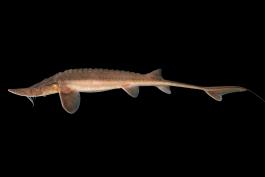
The shovelnose sturgeon has a flattened, shovel-shaped snout. The base of the tail is long, flattened in cross section, and completely covered with plates. The upper lobe of the tail fin has a long, slender filament (often broken off in adults, however). There is not a small opening (spiracle) above and slightly behind the eye (distinguishing it from the lake sturgeon). The nostril opening closest to the eye is larger than the eye. The barbels are fringed. Like the pallid sturgeon, the lower lip has 4 lobes (not 2, as in the lake sturgeon).
The back and sides are light brown or light reddish brown or buff color; the belly is white.
Similar species: The shovelnose sturgeon so closely resembles the endangered pallid sturgeon that the shovelnose is illegal to harvest for commercial purposes. To distinguish the shovelnose from the pallid sturgeon, note these characteristics of the shovelnose:
- The snout is shorter and less pointed.
- The bases of the inner barbels are approximately equally distant between the mouth opening and the snout tip.
- The inner barbels are more strongly fringed and thicker, and the width of their bases are more than half the width of the outer barbel bases.
- The belly is covered with scale-like plates (except in young).
- The tips of the gill rakers on the lower half of the first gill arch are more fanlike, with 3 or more blunt tips on most gill arches.
- The dorsal fin has 30 to 36 (not 37 to 43) rays.
- The anal fin has 18 to 23 (not 24 to 29) rays.
Total length: up to 30 inches; weight: rarely exceeds 5 pounds.

The shovelnose sturgeon is the most abundant sturgeon in the Missouri and Mississippi rivers. It is also occasionally caught in the Current River near Doniphan, Missouri.
Habitat and Conservation
Usually found in open, flowing channels of larger rivers with sandy or gravel bottoms. This species migrates extensively, and individuals have been documented to travel as far as 560 miles.
It is the most abundant sturgeon in Mississippi and Missouri River systems, but numbers are declining likely due to overharvest, dam construction, and habitat alteration.
Food
These bottom-feeding fish consume large numbers of aquatic invertebrates such as midge, caddisfly, mayfly, and stonefly larvae.
Status
Permitted sport fish. Because it so closely resembles the pallid sturgeon (which is in danger of becoming extinct), the shovelnose sturgeon is illegal to harvest for commercial purposes in Missouri.
Life Cycle
Individuals can live at least 14 years and likely longer; they are sexually mature at five to seven years of age.
Human Connections
Sturgeons used to have considerable economic importance in Missouri, but the fishery underwent a sharp decline after 1900. Overfishing, pollution, and dam construction (which blocks migration and destroys habitat) have all contributed to the decline of these unusual, ancestral fish. Slow growth rate and late maturity make the sturgeons, as a group, especially vulnerable to overharvest.
The flesh of sturgeons has an excellent flavor, especially when smoked, and the eggs are used for caviar. There are about 27 species of sturgeons in the world, all in the Northern Hemisphere, with 8 in North America, and 3 in Missouri. Most of the world's sturgeon species are declining, threatened, or endangered. There are global efforts to conserve sturgeon species, and national and international laws are in place for preventing their extinction.
Ecosystem Connections
Sturgeons are ancient fish, little changed from their ancestors in the fossil record dating back to the Triassic period, some 245 to 208 million years ago.
Some sturgeon species are anadromous, annually migrating from seawater habitats upstream into freshwater rivers to spawn. One of these anadromous sturgeons is the critically endangered beluga sturgeon native to the Caspian and Black Sea basins. This is the species harvested for the famously expensive beluga caviar, and now on the brink of extinction due to overfishing and poaching. Females are not able to breed until they are at least 15 years old. Harvesting caviar kills the fish. The largest sturgeon on record was a female beluga sturgeon caught in the estuary of the Volga River in 1827; it was more than 23 feet long and weighed more than 3,000 pounds. It must have been a spectacular fish, and more than 100 years old.





























